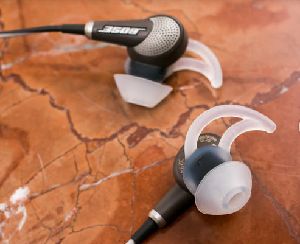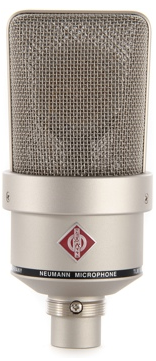 The Bose QuietComfort 20 and 20i (QC20/QC20i) is an in-ear headphone (or I guess you can call them earphones, like we had when I was a kid in the 70s) that by all accounts is the best noise-canceling headphones available that are not big cups that hang off the side of your head.
The Bose QuietComfort 20 and 20i (QC20/QC20i) is an in-ear headphone (or I guess you can call them earphones, like we had when I was a kid in the 70s) that by all accounts is the best noise-canceling headphones available that are not big cups that hang off the side of your head.
I said “by all accounts” because the reviews by the likes of CNET and Forbes have anointed the QC20 the clear winner in the category of noise-cancellation by from, basically, earbuds.
It has become common with people who travel a lot, especially on planes, to block out distracting and irritating noise. The tool of choice for this has become noise-canceling headphones. Typically you have only been able to get this from traditional type headphones, either the kind that go on your ears, or the kind that go over them, fully encompassing your ears and resting on your noggin. That last variety is called “circumaural” or just full size headphones.
Circumaural headphones have the advantage, right off the bat, of being able to block out noise simply because they seal around your ears. This is called passive noise reduction. Then if you add active noise cancellation – electronically preventing certain frequencies from being audible (by means of mirroring incoming sound and creating a negative of it) – and it becomes pretty clear that you can get the most noise reduction from circumaural headphones. That’s why you see so many people on airplanes these days looking like they just came off a firing range. They’re bulky and unwieldy.
So wouldn’t it be great if you could get similar noise-blocking from something a lot more convenient like earbuds? They can provide some passive noise cancellation by physically blocking your ear canal. But if you add in the active noise cancellation too, you can have a much lower profile, lighter, and more convenient experience while traveling.
Of course there are several brands of in-ear noise-cancelling headphones out there. But the Bose QuietComfort 20 and 20i (the 20i being the one specifically designed for Apple iPods, iPhones and iPads) has been dubbed the best of these in several on-line reviews, including this one from CNET – Bose QuietComfort 20 review.
Of course, as with most modern noise-canceling headphones, the QC20s are equipped with in-line mic/remote for Android, Blackberry, and Windows phones. And the QC20i works with iPhones.
So if you are looking for a quiet traveling experience, but don’t want to deal with big, bulky headphones, the best quality you can get comes in the form of the Bose QC20. CLICK HERE for more information or to buy.
What Microphone Was Austin Mahone Using In McDonalds Commercial?
 Wondering what kind of microphone Austin Mahone is using in that MacDonalds ad? On the latest TV commercial for McDonald’s, Austin Mahone is in a recording studio singing into a very interesting looking microphone. It’s called The Bottle, by Blue Microphones. It’s a large diaphragm tube condenser microphone, and is Blue’s flagship mic. Not only does it have the incredible sound of a high quality tube condenser mic, but it has interchangeable capsules, called “bottle caps.” These different capsules, seven in all, offer different types of sound by providing different frequency and sensitivity responses, as well as a variety of pick-up patterns.
Wondering what kind of microphone Austin Mahone is using in that MacDonalds ad? On the latest TV commercial for McDonald’s, Austin Mahone is in a recording studio singing into a very interesting looking microphone. It’s called The Bottle, by Blue Microphones. It’s a large diaphragm tube condenser microphone, and is Blue’s flagship mic. Not only does it have the incredible sound of a high quality tube condenser mic, but it has interchangeable capsules, called “bottle caps.” These different capsules, seven in all, offer different types of sound by providing different frequency and sensitivity responses, as well as a variety of pick-up patterns.
If you’d like more information on the Blue Bottle mic, or even to buy your very own, CLICK HERE. Since this mic is a very high-end piece of gear, and could be outside your budget at just under 6 grand, you might want to have a look at their entire line of microphones, which include excellent mics at all price levels starting at under $100, HERE.
Answers For Someone Moving To Reaper From Ableton Live
Yesterday I received an e-mail form someone who used to work with Ableton Live, but can no longer use that program. So she wanted to know if she could do some of the same things in Reaper that she used to do in Ableton Live.
After answering her e-mail, I thought it would be good information to share in a post. So her questions and my answers are below.
Question 1
I saw in your video (she was referring to the Reaper Tutorial Video) that from an imported audio track it is possible to clip a part to keep and delete the rest; but would it be possible to keep the entire track while only looping a part of it? I remember that it was possible in Live, which was very useful to avoid “manual” pre-clipping editing with another software.
My Answer
Sort of, yes. Not like Live, which is unique in that it isn’t linear like most DAWs. But you can easily and quickly copy “selected area of selected item,” which lets you select the part you want to loop, and copy only that part. Then you can drag just that part down to create a new track. Once you trim it (just drag the edges) to get the loop start and stop points, you’ll want to “glue” the item, which basically renders it in-place as a new file. Then all you have to do is drag the edge of the
new item and slide to the right to loop the item as many times as you want. Then you have the entire original file and a looped segment in the track underneath it.
Question 2
Within this loop above mentioned, would it be possible to make it start from any specific point (like in Live)?
My Answer
I’m not exactly sure how it’s done in Live, but yes, I think so. Once you create your loop segment, you can drag it anywhere on its own track to start wherever you want and copy/paste it to create as many different instances of the same loop starting wherever you put them or drag them. Of course you can put multiple loops (created as described above) on the same track as well. Of course, if you need them to play simultaneously, you simply add another track (ctrl+T). Very easy.
Question 3
In Live, it was possible to correct the BPM matching a loop defined in an audio track (especially because if it was from a non-electronic music source) by snapping and sliding time frames to make the sound waves match the BPM of the audio project. Does Reaper allow this?
My answer
Again, yes. Though probably not in the same way. Reaper Tempo Matching and stretch the loop to fit. From the manual: “Insert into project (on currently selected track), Insert at time selection (stretch/loop to fit)”
Question 4
Finally, your video mention that your opinon about plug-in sound editing has changed. What is it now? What can Reaper do about audio file editing by itself?
My Answer
About 90 percent of it, yes. And what’s better is that you do it all non-destructively, then render it. If something gets messed up, you still have the original file. There are some things though, like sample-level
editing and volume/gain adjustment of just small sections of an item that aren’t easy to do. I still prefer using a separate editor for stuff like that. I hope that all helped!
I am not saying that Reaper is the same as Ableton Live, or that it can replace it. Live is called that for a reason – it can be used in live performances. The reason for that is due to its ability to do many looping tasks on the fly – practically immediately. That is something you can do with Reaper. At least not as easily. If anyone out there has done it, let us know in the comments!
But the person asking the questions had some pretty specific needs for what seemed like a non-live set of applications. And it seems as though Reaper can definitely handle those tasks. Again, if you use both Reaper and Live, let us know in the comments if what I’ve said needs any clarification or corrections.
Cheers!
Ken
Neil Young's Pono High Resolution Audio Project
 In 2012, Neil Young started making waves (ha! – OK, that was an accidental pun) about how the public is consuming audio in a very low-resolution way. For instance, the files you listen to on your iPod, iPhone or other mobile device are data-compressed. That means that files like mp3s and aac audio files have had information removed and rearranged from the original master audio in order to reduce the file size so they can be streamed more easily over the internet. This is why you can put thousands of songs on an iPod too. Young wants the public to be able to listen to the full sound of “high resolution” audio. So he invented a thing called “Pono.” It’s a digital player that would let you hear “the full audio,” instead of the mp3s and aacs we’re listening to now.
In 2012, Neil Young started making waves (ha! – OK, that was an accidental pun) about how the public is consuming audio in a very low-resolution way. For instance, the files you listen to on your iPod, iPhone or other mobile device are data-compressed. That means that files like mp3s and aac audio files have had information removed and rearranged from the original master audio in order to reduce the file size so they can be streamed more easily over the internet. This is why you can put thousands of songs on an iPod too. Young wants the public to be able to listen to the full sound of “high resolution” audio. So he invented a thing called “Pono.” It’s a digital player that would let you hear “the full audio,” instead of the mp3s and aacs we’re listening to now.
The process of creating good-sounding version of much smaller file-sizes for audio began in the early 90s with the mp2 and then mp3. To give you an example of the difference in file size between what is on a CD and the mp3 version – if you take a song from a CD and convert it (people call this “ripping” for some reason) to mp3, you end up with a file that is about a tenth the size of the original file on the CD. For example, a song on a CD might be a 40MB wav file. But when ripped to mp3, it ends up only 4MB.
Additionally, even the files on the CD are technically lower quality than the master recording. CD standards require a 16-bit file (see our article on bit-depth in audio recording here) and a 44.1 KHz sampling rate (see our article on sampling frequency here). But master recordings used to make those CDs are almost always 24-bit and either 48KHz or 96 KHz. So even CDs are “lower rez” than the master recording.
On top of all that, mastering audio can be even higher resolution than 24/96! Some masters are using 192KHz. So it might be natural to think that since 24-bit/96KHz (some call this the minimum “bona-fide high-resolution audio”) is being reduced to 16-bit/44.1KHz on a CD, and then further reduced to create mp3s, that end product on your device should sound like ass, right? Well I’m betting that a good “99-point-a-whole-bunch-more-9s” percent of people could not tell the difference between any of these resolutions. It isn’t like your TV screen, where the difference between standard and HD is painfully obvious to most people. In audio, it just isn’t so obvious.
However, a small percentage of true audiophiles can certainly hear a difference, and they think it’s a shame that the audio consuming public is mostly listening to what they consider to be inferior quality audio. One such person is Neil Young. There was a large publicity push about Pono in 2012. But then it seemed to quietly fade as an idea. So what is the latest status? Take a look at this article for the latest on Pono.
http://news.cnet.com/8301-13645_3-57608168-47/whats-up-with-neil-youngs-pono-high-resolution-music-system/
What Microphone Did Neal Caffrey Use In White Collar?
 On the Oct 17th season premiere of the USA show, White Collar, Neal Caffrey records his voice into a microphone to impersonate the voice of his father in order to convince authorities to release Peter. The microphone he used was a lovely Neumann TLM 103 microphone. I have several microphones on my bucket list – or… whatever you call the list you put desired microphones on. The TLM 103 is near the top of that list (see my post – Sennheiser MKH 416 Shotgun Microphone Review for the mic in the #1 position).
On the Oct 17th season premiere of the USA show, White Collar, Neal Caffrey records his voice into a microphone to impersonate the voice of his father in order to convince authorities to release Peter. The microphone he used was a lovely Neumann TLM 103 microphone. I have several microphones on my bucket list – or… whatever you call the list you put desired microphones on. The TLM 103 is near the top of that list (see my post – Sennheiser MKH 416 Shotgun Microphone Review for the mic in the #1 position).
Neumann is renowned for making top-notch microphones. I’d be happy to have any of them, or…all of them:). The 103 is likely to be the one to get me in the least trouble with my wife, though. At about $1,100, it’s one of the more affordable Neumann’s, which is a bargain compared to the classic Neumann U87, which you can have for a mere $3,600. Of course it is worth it if you can muster the dough.
I’m always curious when a microphone shows up on a popular TV show. I thought others might be too. So I usually go to the internet and start researching. But when it’s a Neumann TLM 103, there is no research needed. I’d recognize it anywhere.
The TLM 103 is a large-diaphragm condenser (LDC) mic. It’s terrific for vocals – both for voice-over use and, of course, singing. And as with most LDCs, it’s also great as an all-around mic particularly good at recording acoustic guitar, piano, drum-kit overheads, etc.
If you want to order one for your very own, B&H has them here. And they offer free shipping.